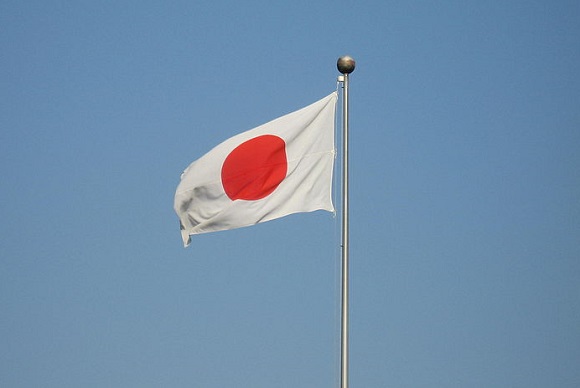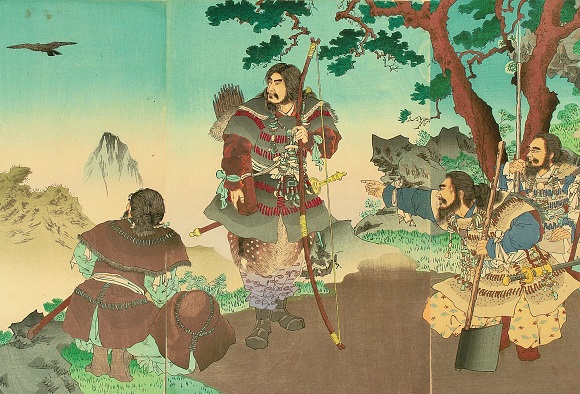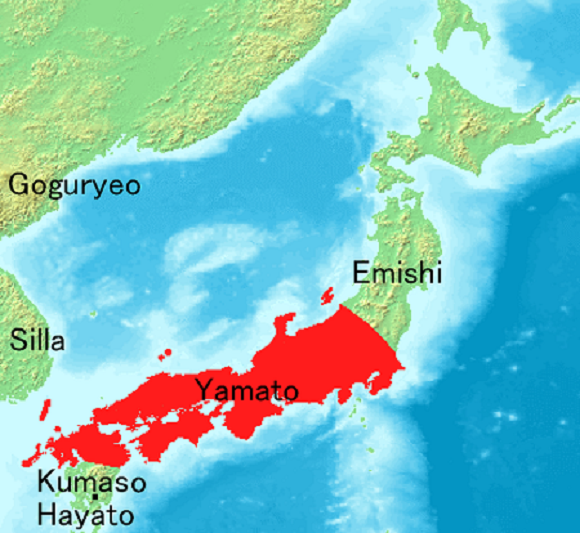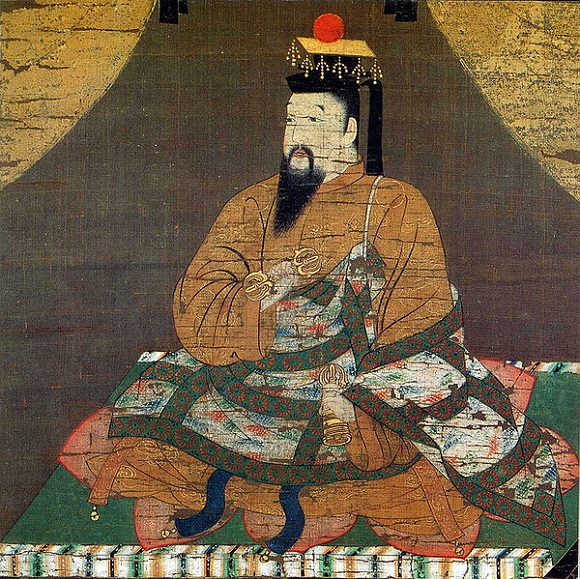
“Happy birthday to you! Happy birthday to you! Happy birthday, dear Jaaapaaaan! Happy birthday to you!!! Yah! Now, blow out your candles! All 2,674 of them!”
Today is a national holiday here in Japan: It’s Kenkoku Kinenbi, or National Foundation Day in English. The day is a celebration of the foundation of Japan, which occurred on February 11 in 660 BCE.
Or was it?!
▼ Emperor Jimmu, the first emperor of Japan and possible ancestor of Davy Crockett
According to legend, Japan is the oldest country in the world, having existed since its founding by Emperor Jimmu in 660 BCE. This is, of course, based off of the myth recorded in the Kojiki, the earliest extant work of Japanese history available to us, but even the CIA World Factbook lists the date as the “traditional date of the founding of the nation by Emperor Jimmu.” Of course, the problem here is that while the Kojiki may be partly based on fact, it’s impossible to say how much, and it’s possible that “Emperor Jimmu” never existed!
▼ But if the CIA says it, it must be true!
Still, February 11, 660 BCE is commonly accepted as the cultural founding of Japan–though the earliest “historically real” emperor is identified as Emperor Ōjin, who is believed to have ruled from around 270 to 310 CE. Following this, Emperor Kimmei is the earliest Japanese emperor with confirmed dates of rule: From 539 to 571.
▼ Emperor Ōjin, doing his best ZZ Top impression
Of course, Japan in the sixth century was a completely different place than what we normally think of as “Japan” today. At that time, no one would have even recognized the name–it was called “Yamato” and the Emperor’s rule over the archipelago wasn’t absolute. However, you could justifiably say that this was the beginning of Japanese society as we know it today thanks to the formal introduction of Buddhism to Japanese society.
▼ The red section roughly marks the area controlled by the emperor during the Yamato period.
A great stretch of time lies between the Yamato period and today, during which time the Japanese archipelago underwent violent social upheavals in the form of multiple civil wars. While the Imperial line managed to survive, the claim that it has remained unbroken since 660 BCE is slightly overstated, as the Nanboku-cho, a period of time during which there were two emperors in Japan, established a tradition whereby successive emperors were alternately selected from the two lines.
▼ Emperor Go-daigo, the cause of a whole lot of trouble!
But for many historians, Japan didn’t actually come into existence until the ratification of the Meiji Constitution on November 29, 1890, which established a constitutional monarchy. On the other hand, the Meiji government fell with the end of World War II, after which the current Japanese government was established on May 3, 1947, founding what many historians think of as Japan.
▼ Emperor Meiji, knowing he looks super fly.
So, where does all this leave us? Well, it really depends on what you consider a country to be! If you think of a country purely in terms of government, then Japan is less than a century old. But few people would think of country solely in political or geographic terms. While the concept of the nation-state is a relatively modern invention, there has long existed the very visceral feeling of a country as being a shared cultural experience–standing on the shoulders of giants as it were. And it is that definition of country which best fits Japan, a county with a long and grand history and culture!
So, even if Emperor Jimmu wasn’t real, and even if no one actually knows when Japan was founded, we still like to think of this day, 2,674 years ago, as the birth of one of the craziest, wildest, most exciting, and most beautiful places on earth.
Happy birthday, Japan! Here’s to a couple more millennia!
Sources and images: CIA World Factbook, Naver Matome, Wikipedia (Emperor Jimmu, Emperor Ōjin, Yamato Period, Emperor Godaigo, Emperor Meiji, Flag of Japan)







 Sanrio theme park in Japan announces plans to expand into a Sanrio resort
Sanrio theme park in Japan announces plans to expand into a Sanrio resort Dagashiya Ahiru Shop is a hidden gem for Japanese snacks lovers
Dagashiya Ahiru Shop is a hidden gem for Japanese snacks lovers What’s at the top of this giant escalator in Japan?
What’s at the top of this giant escalator in Japan? Japan’s first hotel with a human washing machine is now ready for you to come and bathe in it
Japan’s first hotel with a human washing machine is now ready for you to come and bathe in it Old-school train car and tourist information center in Shibuya set to move to Akita this summer
Old-school train car and tourist information center in Shibuya set to move to Akita this summer Sanrio theme park in Japan announces plans to expand into a Sanrio resort
Sanrio theme park in Japan announces plans to expand into a Sanrio resort Dagashiya Ahiru Shop is a hidden gem for Japanese snacks lovers
Dagashiya Ahiru Shop is a hidden gem for Japanese snacks lovers What’s at the top of this giant escalator in Japan?
What’s at the top of this giant escalator in Japan? Japan’s first hotel with a human washing machine is now ready for you to come and bathe in it
Japan’s first hotel with a human washing machine is now ready for you to come and bathe in it Old-school train car and tourist information center in Shibuya set to move to Akita this summer
Old-school train car and tourist information center in Shibuya set to move to Akita this summer Animate Akihabara releases a lucky bag for the first time in years, and it’s amazing
Animate Akihabara releases a lucky bag for the first time in years, and it’s amazing Coca-Cola to release their healthiest cola ever in Japan this March
Coca-Cola to release their healthiest cola ever in Japan this March Uniqlo Ukiyo-e Blue T-shirts: A cool-hued reinterpretation of some of Japan’s greatest paintings
Uniqlo Ukiyo-e Blue T-shirts: A cool-hued reinterpretation of some of Japan’s greatest paintings Once you hear this lady sing “Yooooooghurppe”, you may never stop hearing it
Once you hear this lady sing “Yooooooghurppe”, you may never stop hearing it Is the all-you-can-eat KFC buffet in Tokyo really as good as they say it is?
Is the all-you-can-eat KFC buffet in Tokyo really as good as they say it is? Nintendo’s Kirby now delivering orders at Kura Sushi restaurants, but not in Japan
Nintendo’s Kirby now delivering orders at Kura Sushi restaurants, but not in Japan Stamina-destroying “Paralysis Noodles” are Tokyo’s newest over-the-top ramen innovation
Stamina-destroying “Paralysis Noodles” are Tokyo’s newest over-the-top ramen innovation Japan considering raising international traveler departure tax even more than previously reported
Japan considering raising international traveler departure tax even more than previously reported Is China’s don’t-go-to-Japan warning affecting tourist crowds in Shibuya’s Don Quijote?
Is China’s don’t-go-to-Japan warning affecting tourist crowds in Shibuya’s Don Quijote? China’s don’t-go-to-Japan warning seems to be affecting Osaka’s Namba and Dotonbori neighborhoods
China’s don’t-go-to-Japan warning seems to be affecting Osaka’s Namba and Dotonbori neighborhoods Japan’s EF English Proficiency Index rank drops for 11th straight year, hits lowest ever
Japan’s EF English Proficiency Index rank drops for 11th straight year, hits lowest ever Chinese government’s don’t-go-to-Japan warning has heartwarming non-effect on Yokohama Chinatown
Chinese government’s don’t-go-to-Japan warning has heartwarming non-effect on Yokohama Chinatown KFC Japan opens a Christmas restaurant in Tokyo…but why???
KFC Japan opens a Christmas restaurant in Tokyo…but why??? Studio Ghibli adds new Kiki’s Delivery Service music box to its anime merchandise shop in Japan
Studio Ghibli adds new Kiki’s Delivery Service music box to its anime merchandise shop in Japan Japan’s human washing machines will go on sale to general public, demos to be held in Tokyo
Japan’s human washing machines will go on sale to general public, demos to be held in Tokyo Starbucks Japan unveils new Christmas goods and a rhinestone tumbler that costs 19,500 yen
Starbucks Japan unveils new Christmas goods and a rhinestone tumbler that costs 19,500 yen Real-world Nausicaa Ghibli anime glider completes its final flight in Japan【Video】
Real-world Nausicaa Ghibli anime glider completes its final flight in Japan【Video】 Japanese train company is letting fans buy its actual ticket gates for their homes
Japanese train company is letting fans buy its actual ticket gates for their homes Is China’s don’t-go-to-Japan warning affecting tourist crowds in Tokyo’s Asakusa neighborhood?
Is China’s don’t-go-to-Japan warning affecting tourist crowds in Tokyo’s Asakusa neighborhood? The 10 best day trips from downtown Tokyo【Survey】
The 10 best day trips from downtown Tokyo【Survey】 Brand-new Pokémon park opens in Japan with larger-than-life-size Lapras【Photos】
Brand-new Pokémon park opens in Japan with larger-than-life-size Lapras【Photos】 Japanese government considering tripling departure taxes to combat overtourism
Japanese government considering tripling departure taxes to combat overtourism Starbucks Japan unveils the new Soupuccino
Starbucks Japan unveils the new Soupuccino Survey asks foreign tourists what bothered them in Japan, more than half gave same answer
Survey asks foreign tourists what bothered them in Japan, more than half gave same answer Japan’s deadliest food claims more victims, but why do people keep eating it for New Year’s?
Japan’s deadliest food claims more victims, but why do people keep eating it for New Year’s? We deeply regret going into this tunnel on our walk in the mountains of Japan
We deeply regret going into this tunnel on our walk in the mountains of Japan Studio Ghibli releases Kodama forest spirits from Princess Mononoke to light up your home
Studio Ghibli releases Kodama forest spirits from Princess Mononoke to light up your home Major Japanese hotel chain says reservations via overseas booking sites may not be valid
Major Japanese hotel chain says reservations via overseas booking sites may not be valid Put sesame oil in your coffee? Japanese maker says it’s the best way to start your day【Taste test】
Put sesame oil in your coffee? Japanese maker says it’s the best way to start your day【Taste test】 The top 10 annoying foreign tourist behaviors on trains, as chosen by Japanese people【Survey】
The top 10 annoying foreign tourist behaviors on trains, as chosen by Japanese people【Survey】 No more using real katana for tourism activities, Japan’s National Police Agency says
No more using real katana for tourism activities, Japan’s National Police Agency says Starbucks Japan reveals new sakura drinkware collection, inspired by evening cherry blossoms
Starbucks Japan reveals new sakura drinkware collection, inspired by evening cherry blossoms Animate Akihabara releases a lucky bag for the first time in years, and it’s amazing
Animate Akihabara releases a lucky bag for the first time in years, and it’s amazing Coca-Cola to release their healthiest cola ever in Japan this March
Coca-Cola to release their healthiest cola ever in Japan this March Uniqlo Ukiyo-e Blue T-shirts: A cool-hued reinterpretation of some of Japan’s greatest paintings
Uniqlo Ukiyo-e Blue T-shirts: A cool-hued reinterpretation of some of Japan’s greatest paintings Once you hear this lady sing “Yooooooghurppe”, you may never stop hearing it
Once you hear this lady sing “Yooooooghurppe”, you may never stop hearing it Is the all-you-can-eat KFC buffet in Tokyo really as good as they say it is?
Is the all-you-can-eat KFC buffet in Tokyo really as good as they say it is? A history of Japanese schoolgirls’ purikura sticker booth trends
A history of Japanese schoolgirls’ purikura sticker booth trends Pizza Hut’s new Oreo pizza is like nothing we’ve ever eaten before
Pizza Hut’s new Oreo pizza is like nothing we’ve ever eaten before Sleep in a futuristic space pod at this interstellar capsule hotel just outside of Tokyo
Sleep in a futuristic space pod at this interstellar capsule hotel just outside of Tokyo Japan’s Shinkansen trains are getting a Super Mario makeover【Pics】
Japan’s Shinkansen trains are getting a Super Mario makeover【Pics】 Getting a driver’s license in Japan the hard way: The first driving test again
Getting a driver’s license in Japan the hard way: The first driving test again We deeply regret spending five hours on this artistic Japanese island (we should have spent more)
We deeply regret spending five hours on this artistic Japanese island (we should have spent more) Unique inclined elevator in Japan leads to a town that inspired Studio Ghibli’s Spirited Away
Unique inclined elevator in Japan leads to a town that inspired Studio Ghibli’s Spirited Away Tokyo’s luckiest lottery ticket shop draws huuuuuuuge crowds on Japanese lucky day
Tokyo’s luckiest lottery ticket shop draws huuuuuuuge crowds on Japanese lucky day Anime and video game backgrounds now free to download for video conference calls
Anime and video game backgrounds now free to download for video conference calls
Leave a Reply